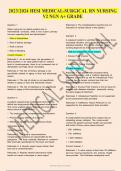Exam (elaborations)
2024/2025 HESI MEDICAL-SURGICAL RN NURSING V2 NGN A+ GRADE
- Course
- Institution
2023/2024 HESI MEDICAL-SURGICAL RN NURSING V2 NGN A+ GRADE Question 1 When caring for an elderly patient who is intermittently confused, what is the nurse‘s primary concern regarding fluid and electrolytes? 1.Risk of dehydration 2.Risk of kidney damage 3.Risk of stroke 4.Risk of bleed...
[Show more]



